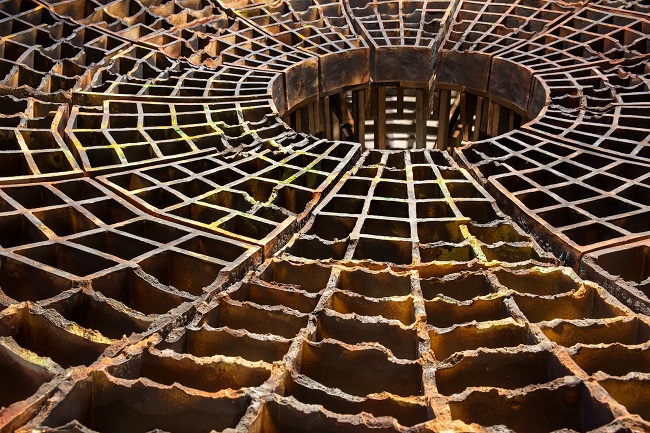The following is Paul Northway’s essay on Peter Christian Johnson’s 2013 exhibition at the Archie Bray Foundation for the Ceramic Arts in Helena, Montana. Northway was the Jentel Critic at Bray in 2013, which is a residency for writers interested in the ceramic arts.
Peter Christian Johnson-Constructing Labor
If an ideal setting exists to showcase Peter Christian Johnson’s sculpture, one would be hard-pressed to find an environment more suitable than the grounds of the Archie Bray Foundation. The work would appear as welcome guests among the remnants of industrial decay, joining an audience of objects proudly displaying surfaces etched with the evidence of wear and tear. The relationship would be short-lived though, for this is a well-documented landscape of artifacts from which a purpose and function can be affixed. Isolate Johnson’s sculpture away from the rubble and the circumstances switch from eroding objects to an erosion of context. What remains is a genuine tribute to human labor and engineering, conceived by intuition and honed through his methodical construction process.
Although some might legitimately argue that a CNC router, a 3D printer, or other machines of industrial fabrication could provide an easier path to a resolved sculpture, the use of one of these devices would come with the risk of rendering Johnson’s motivation obsolete. The argument could be further bolstered because Johnson does not leave any trace of the maker on the surface of his objects. Therefore, we trust that his meticulous process must be intrinsically linked to the content of his sculpture. The conceptual link may arise in our own amazement when we try to comprehend how something was constructed, and in our wonderment as to why it was constructed. To illustrate this concept on a grandiose scale: We are amazed at the incredible feats of human engineering of the Incas and Mayans, but we do not possess a definitive answer as to the motivation behind this tremendous investment of labor.
We are left to wonder what an artist thinks about during those countless hours of labor in the studio. This is a complicated question and the answer changes as the work moves toward fruition. For Johnson, the birth of an idea is a very small moment in time when compared to the entire process from start to finish. Sketches are drawn, drawings are rendered through 3D software, patterns are printed, but the majority of Johnson’s time is spent rolling out slabs of clay, taking measurements, making tests, and analyzing results. It is during these lengthy periods in the studio when Johnson spends enough time with his intuition that he emerges with a confident product.
Johnson’s undergraduate studies are in environmental science, which have afforded him with more than a general understanding of how our human relationships and perceptions affect our natural environment. His sculptures evoke images of parts from generators, turbines and internal skeletons— perhaps in reference to a 1950s hydro plant tour, or maybe they are fragmented artifacts discovered on the surface of Mars. Either way, Johnson’s retro-futuristic aesthetic captivates his audiences. If the study of science has taught him anything, it is that experiments may yield unexpected results, even when they are tightly controlled.
Johnson has taken a yearlong sabbatical from his teaching to experiment in the studio. We are beginning to see forms with encrusted shells exposing the internal structures. Johnson is a recent first time father so perhaps we are seeing the products of the molded plastic toys and toddler paraphernalia at his feet, or the fatherly impulse persuading him to cast a protective skin over his environment. We will have to patiently wait until the labor of Johnson’s intuitive process yield the results.
Text by Paul Northway, the 2013 Jentel Critic at the Archie Bray Foundation. He holds an MFA in ceramics from the University of Montana and currently serves as Assistant Professor of Art at Northwest Vista College, San Antonio, Texas.
Peter Christian Johnson is an Associate Professor of Art at Eastern Oregon University. He earned his MFA from Penn State University and a BS in Environmental Science at Wheaton College. Peter has been a resident artist and visiting lecturer at the Alberta College of Art and Design, Australian National University, The Archie Bray Foundation, the LH Project, and the Odyssey Center for Ceramic Arts. His work has been exhibited in Canada, Australia, and throughout the United States.
CFile learned of this project through our submissions process. We welcome our readers to submit their own work for publication.
Above image: Peter Christian Johnson, Mandala, 2013. Ceramic and wood. Image courtesy of the artist. Photograph by Kurt Keller Photography.


Peter Christian Johnson, Mandala, 2013. Ceramic and wood.


Peter Christian Johnson, Ovoid #2, 2013. Ceramic.

Peter Christian Johnson, Ovoid #1, 2013. Ceramic.

Peter Christian Johnson, Wing #1, 2013. Ceramic, steel, wood.

Peter Christian Johnson, Wing #2, 2013. Ceramic. All images courtesy of the artist. All photography by Kurt Keller Photography.
Visit the Archie Bray Foundation for the Ceramic Arts

Very interestring work! Congratulations!
Wonderful work